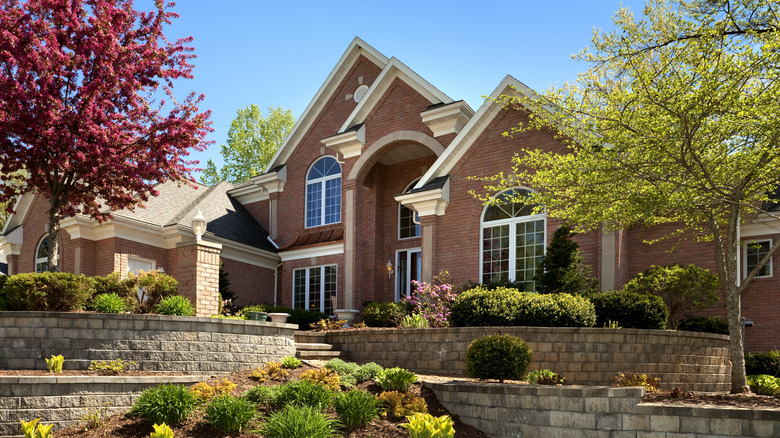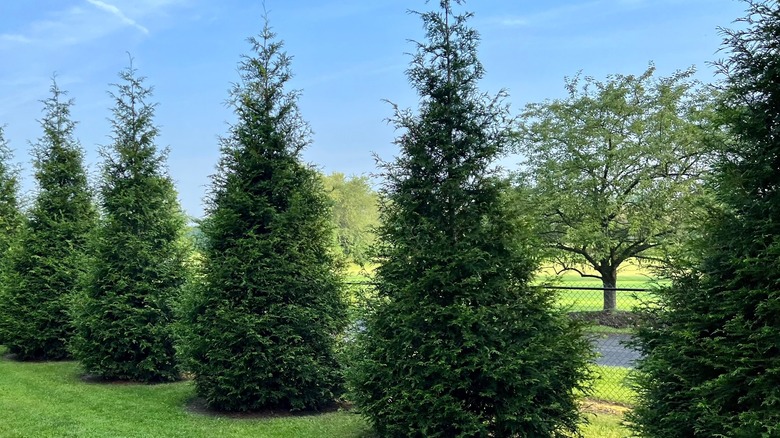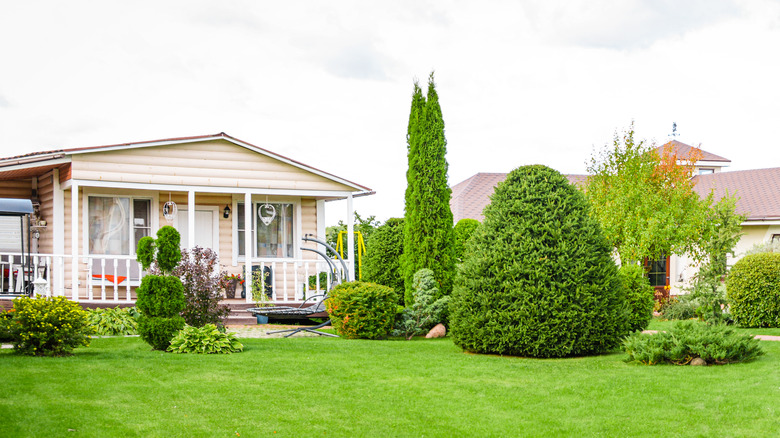The Type Of Tree You Might Want To Reconsider Planting In Your Yard
You might already know about many different kinds of plants you shouldn't grow right next to your house because of the possibility of causing damage. Certain trees and shrubs can cause harm to siding or may deposit leaves and seeds in gutters, resulting in clogs.
One type of tree that can cause more damage than you might think when planted close to your home is an evergreen conifer, which is commonly used as a Christmas tree. Although it might seem nice to have a traditional-looking tree you can decorate with lights for the holidays near the house, these trees can be problematic to have near your home.
One of the biggest dangers of planting an evergreen close to your house is its risk of catching fire and burning quickly. These trees have a lot of volatile oils and sap in their branches, providing fuel for any fire that starts. If you plant more than one conifer near your home, a fire could spread quickly among the tightly packed trees, using dead needles on the ground for additional fuel. These trees tend to grow tall and spread over the top of other plants you have near your home, which means tall flames could reach your eaves or roof line. If additional dead needles accumulate on the roof or in the gutters, they can burn quickly, too.
Dropped needles from evergreens aren't just a fire hazard
Although conifers are trending in popularity for planting in front yards, you might want to plant them at a distance from the house. Beyond the fire hazard, the needles from these trees can cause multiple problems as they drop. These needles tend to drop after two to five years of life as a normal part of desiccating. Considering mature evergreens often reach 20 to 60 feet in height, these trees are dropping a large number of needles over a five-year span.
If the falling needles land on your roof because the conifer is planted close to the house, they can trap moisture, which encourages moss and mold growth. The moisture retention may speed up when needles clump together, causing shingles to deteriorate. Wind could force the needles under the edges of your shingles, creating a gap for water to penetrate and begin leaking into your house.
If evergreens are close to your home and grow above the roofline, dropped needles may end up in your gutters, causing clogs. With clogs in the gutters, water will spill over the top of the gutters and potentially damage your foundation. It could also back up toward the roof, prematurely damaging the shingles or causing moisture damage to the roof decking materials. If this moisture freezes and thaws repeatedly, it could lead to further damage and new leaks.
Conifers' root growth can cause foundation problems
If you plant these trees too close to the house, the evergreen's roots can reach the foundation, causing damage. During a drought period, the trees could pull much of the moisture out of the soil near the foundation, causing soil shrinkage that can lead to foundation shifting or structural cracking. A well-built foundation that doesn't have gaps or cracks should be able to stand up to an invasion of tree roots, but the roots will exploit any weak spots in the foundation they encounter.
Additionally, trees planted too close to a home's foundation can have lopsided roots, as they're weaker near the foundation and stronger in the other direction, which makes the tree less stable. The roots close to the foundation simply cannot spread out as much as they normally would. And during storms, a large conifer tree can be uprooted by the wind when the soil is saturated. If it's planted too close to your house, it could fall on your roof and cause it to collapse or could damage other structural elements.
For reasons including fire hazards, roof damage, gutter clogs, and foundation damage, you should not plant evergreen conifers close to the house. If you like the way these trees look, consider layering evergreen trees for privacy away from the home, creating a windbreak.


